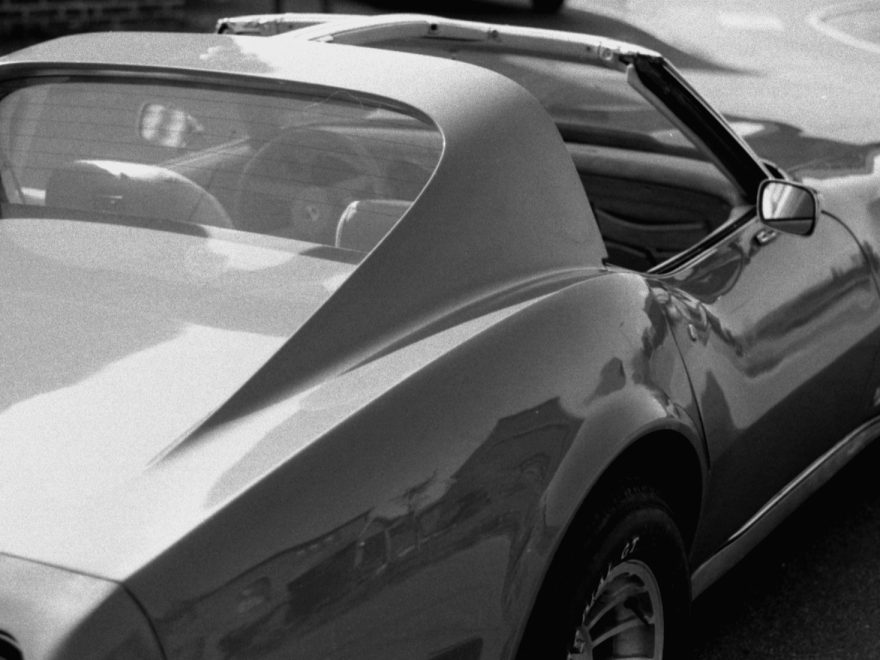Two American cars have been around longer than the Corvette: The Chevy Suburban and the Ford F-150. Neither of which is as sexy or as loveable.
Americans fell hard for the ‘Vette in the 1950’s. Though there have been a few low points in the romance, few of us forget the first time we laid eyes on her.
Whether it was the stingray or the first convertible, it made an impression. The original makers put the then-stodgy GM imprint on a fast-growing, prosperous America.
The twin flag moniker became the personification of how fast we were heading to the future. After all, if we’re heading through the decade’s high speed, it may as well be in a Corvette.
Find Your Online Car Repair Manual Today! ->>
Its 60+year history is about a sweet ride, for sure, but it’s also about lasting love. Today, millions of fans search for Corvette parts to keep the flame going.
Here’s the Corvette history that tells us much about ourselves, too.
Mid-Century Growing Pains
Head designer for GM, Harley Earl, saw a Jaguar XK120 in the early 50’s and an idea began. GM was not famous for sports cars, but Earl was smitten.
Less than two years later, a dream car from Chevrolet, known as the EX-122 has a guest appearance at GM’s Motorama. The two-seater stands out with red interior and exterior and big white walls.
The guts hold a 150 HP engine and two-speed transmission. It began rolling off the assembly line within months, with two options: an AM radio and a heater.
By the mid-50’s, the engine grew to a 256-cubic inch V8 with two four-barrel carbs. Less than a dozen buyers opt for a high-lift cam. The standard for this Corvette’s time were new roll-up windows.
Also, cutting edge seat belts, exposed headlamps, and distinct curve side design. Sports Car Illustrated says of GM, “[they] are now building a sports car.”
By the late 50’s, ponies were up to 283 thanks to 327-cubic inch V8 in the small block engine. A new fuel injection system and 4-speed transmission get drivers to a pounding 132 MPH.
Designers began pushing GM to get into Corvette racing but got a refusal. These were the years the 4 round tail lights make their first appearance.
The Best Two Words From the 60’s: Sting Ray
The 1963 introduction of the Sting Ray (yes, it was two words then) was GM’s bid to fare with Europe’s machines of the day. And, this began the hidden headlamps along with the infamous split-window fastback.
The design is smaller with independent rear suspension and electronic ignition. The Z06 edition of the Corvette Grand Sports program builds five race-ready models.
By the later 60’s, Holley Carbs become standard. The engine is now the L88 cast-iron monster and tops at 500 hp in routine testing. Though its muscle is infamous, the selling price stays below $5,000 with most options.
The initial Sting Ray name from 1963 returns in 1969 as Stingray with a roll-out of the 250,000th Corvette. And what better reintroduction than its striking gold convertible.
The big block V8 is now available in aluminum. The infamous curvy hatchback prompts comparisons to “Barbarella.”
Today, thousands of fans love this as a restoration project.
T-Tops, Elephant Bells, and Longer Hair
The 70’s mark some changes for the ‘Vette, though some did not sit well with purists. The big-block 454 V8 has its first introduction along with fender flares.
But, some of the stylish chrome starts going the way of flat-top haircuts and Brylcream.
Plastic replaces the shiny nose candy as well as the rear chrome bumperettes. And, 1975 is the last year for the convertible. But, the T-Top is still available for avid sun-worshipers.
This is also the year the catalytic converter emerges, and the V8 now produces a disappointing 165 HP.
1978 marks Corvette’s 25th year, and makers roll-out a celebratory version. The twin flags get a replacement edition marker. Thousands of buyers plunk down 50% over the base price for an extra.
A two-tone Pace Car replica. (huh?)
The news isn’t all bad. Die-hard speed enthusiasts aside, the Corvette beat all previous sales records in 1979. Many believe it was the introduction of AM/FM with integrated CB radio.
It may also be due to this “high-tech” feature that an anti-theft device is part of the new package.
Full-On 80’s Disco-Lit Cockpit
Corvette took on some much necessary changes in the 80’s, taking time in 1983 for new additions. A spoiler, lighter hood, and aluminum differential housing reduce weight and drag.
There were no less than 43 prototypes made for 1984, but a 750,000th Vette rolls out before the year begins.
Following the prototypes, the 1984 edition hits the road without the Stingray name. Its smaller frame sports power rack and pinion steering.
There are now aluminum control arms and one piece removable roof. The star of the year is the engine. It throws some impressive shade at prior year’s disappointments.
205 HP with 290 pounds of torque tops 138 mph speeds. Acceleration from 0-60 is less than 7 seconds, and slowing the demon down is easy, too. Skid-pad grips give it dead-stop skills.
After years of “dogs,” the new ‘Vette receives dubbing as “a dead serious sports car” from experts.
Adulation brought makers to return the convertible in 1986. In 1989, the Doug Nash manual transmission ushers in a hefty 6-speed from Chevrolet.
Though our beloved sex symbol makes a comeback, it isn’t without a few hiccups. This is the time of space invaders and disco. Liquid crystal bar graphs, metric readouts, and multicolored lights may be 80’s cool.
But, they cause the dash to look like a video game console of the time. Some serious drivers took offense.
90’s Consumption and a Return to Corvette History
This decade brings the ‘Vette backs to its roots in many ways. In 1991, the new model passes the 911-turbo in speed and control.
New traction control becomes standard. The one-millionth Corvette rolls out in July of the same year.
The candy-apple red interior white convertible mimics the first model of the 50’s. Finally, GM registers “Stingray” as a trademark, giving fans more to celebrate.
Special Editions come with ruby red and bright purple exteriors. But, colors of the mid-nineties belie some serious engine changes.
By 1996, the 350-cubic-inch small block rates in at 330 HP. The “Selective Real Time Damping” system is in use for the first time.
In 1997, experts put purists long lists of gripes from prior years in the burn barrel. The 345 HP V8 powers a smaller version ‘Vette.
There’s now a backbone frame, rear transaxle, and front suspension. Impressive speeds and hairpin tuned handling are back.
The late 90’s version is almost 100 pounds lighter. And, they sport an affordable price for the cash-flush Reagan era. Once again, the Corvette is a performance vehicle.
The Early Aughts at 186 Miles Per Hour
By 2001, our beloved Vette is clocking in at speeds over 170 mph. Acceleration to 60 mph is 4.3 seconds, signaling to buyers that designers were listening.
But, more improvements were coming. Makers want more “redesign” than reinventing. Front grills add airflow to the engine compartment. Shortening the body by more than 5 inches ratchets up performance.
Horsepower passes the 400 mark, and speeds hit 186 mph. The addition of a carbon fiber hood is the first in North America.
Active Handling and Traction Control Systems maintain an even drive. Designers then turn to the interior of this performance dream car. Upgrades include cozy seats and inner power for the convertible top.
The maker’s desire for commuters comfort provides dash stitching and sweet wood grain. Almost unbelievable, but sticker prices remain stable. The introduction of a lower-priced version sent fans to dealerships by the thousands.
2010’s Thunder of Over 400 Horses
By 2010, there are seven models from which to choose. The supercharged muscle of the 6.2-liter engine offer speeds up to 200 mph. And the decade brings a few eye-catching special editions.
Chevrolet’s 100th birthday brings fans a Centennial Edition. The package is complete with black satin graphics. There’s also red stripe trimmed-out interior and the monster engine of the decade.
In 2013, Corvette celebrated its 60th birthday with a single year convertible. The sleek edition tops 60 mph in less than 4 seconds. Fans were in for new convertible Stingray edition starting the following year. Finally!
By 2015, new Vettes come standard with a 455 HP push rod mammoth with a 6-speed automatic or 7-speed manual. There’s a lower profile tire selection.
Electronic control slip differential makes the drive speedy and tight. The interior design features sleek new accessories and plush seats.
The 2019 model may be the one which goes down in Corvette history as the fastest of the herd. A 755 HP with 715 pounds of torque rocket the newest version to 60 MPH in less than 3 seconds.
Top speeds exceed 200 mph. With only 3,000 models available for sale, those who scoop one up are either race drivers or are ready to die trying.
Keep Your Ride Ready for Anything
If Corvette history teaches us, it’s that fine machines are both engineering and art.
No matter what kind of ride you own, making sure it performs at its best is your job.
We’ve got plenty of help. Take a look at our manuals and blogs for best tips on keeping your ride running the way designers mean it to.







